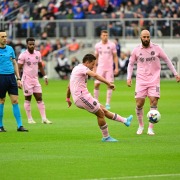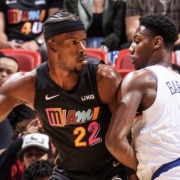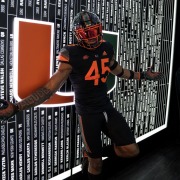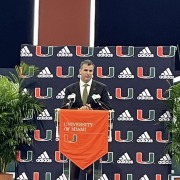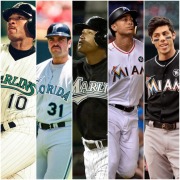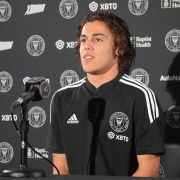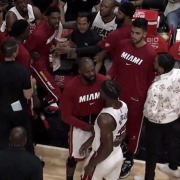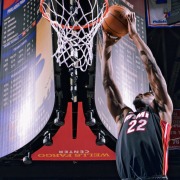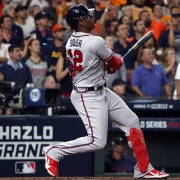The Miami Marlins have long been negatively associated with the term ‘fire sale.’ Too often in the franchise’s history, ownership groups (yes, more than one) gutted a talented roster to save money. The team trafficked in hope with prospect packages, parting with players in their prime. The Marlins sabotaged local support by blundering these blockbuster trades throughout their history.
This week, the book closed on yet another blundered blockbuster. The Marlins designated Isan Diaz for assignment to open a roster spot for the newly signed slugger Jorge Soler. The Yelich deal stands among many failures for the Fish over the years.
There’s no singular reason behind Miami’s seeming inability to “win” these transactions, beyond bad luck and maybe misguided management. Some of the moves paid off in short bursts, but over time, most soured on them.
The Marlins find themselves on the cusp of contention once again and could be nearing another blockbuster trade. These days, Miami’s in a position to bring in the All-Star talent rather than part with it. But so far, the Marlins have balked at the cost of premium prospects demanded by other clubs. Given their blundering history with these deals, it’s easy to understand why.
Marlins First Foray into Blockbuster Trades
The first of (too) many blockbuster trades in Marlins history dates back to the club’s inaugural season. On June 24, 1993, the Marlins made their first in-season trade as a Major League franchise.
Florida acquired 24-year-old All-Star Gary Sheffield and left-handed pitcher Rich Rodriguez from the San Diego Padres. In exchange, Florida sent rookie reliever Trevor Hoffman, as well as minor league arms Andrés Berumen and José Martinez, to the Padres.
Marlins Return on the Trade
Sheffield’s impact with the Marlins was immediate. He became the early face of the franchise, thanks to his bat wag and long balls. He and closer Bryan Harvey were the team’s first-ever All-Stars.
Over parts of six seasons in Miami, Sheffield hit 122 home runs, with a .288 batting average and .970 OPS, and drove in 380 runs. He earned two All-Star berths and won a Silver Slugger. Most importantly, he helped the Marlins win the 1997 World Series.
This information alone seemingly tilts this blockbuster trade in the Marlins’ favor—that is, until you factor in Hoffman’s place among the all-time greats. No one could have predicted Hoffman’s Hall-of-Fame future, something Sheffield’s still waiting on (though he shouldn’t be). It’s not a clear win for the Fish, nor an abject failure.
Unforeseen Cost for the Fish
Hoffman came to the Marlins in the 1992 expansion draft. With the eighth pick, Florida plucked the relief pitcher from the Cincinnati Reds organization. He made the Marlins’ inaugural roster as a set-up man for Harvey. But after just three months (and his first two career saves), Hoffman became the centerpiece in the return package for the Padres.
San Diego put on a fire sale of their own in 1993, trading away Tony Fernandez and Darrin Jackson before dealing Sheffield. The Padres later dealt Fred McGriff and failed to sign draftees Todd Helton and Troy Glaus. They let catcher Benito Santiago go in free agency. (The four-time All-Star signed in Florida and started the franchise’s first game.) San Diego stopped short of trading Tony Gwynn.
New Padres general manager Randy Smith wanted Hoffman as part of the trade for Sheffield. Smith had come to the Padres from the Colorado Rockies, where he’d helped prep for the ’92 expansion draft where Florida had found Hoffman (Berumen and Martinez, too).
Then-Marlins GM Dave Dombrowski offered Berumen, Matt Whisenant, and Darrell Whitmore, but Smith insisted on Hoffman. Florida acquiesced, surrendering a reliever who’d been projected as a catcher in the pros and played shortstop and third base before transitioning to the bullpen.
Hoffman overcame changing positions, injuries, and diminished fastball velocity to become MLB’s all-time saves leader in 2006. With his “Bugs Bunny” changeup as an out-pitch, Hoffman helped San Diego make five playoff appearances, including a trip to the 1998 World Series.
Hoffman finished his career with 601 saves and seven All-Star berths, twice finishing runner-up for the NL Cy Young award. Mariano Rivera broke the career saves record in 2011, but Hoffman’s still No. 2 all-time. The nearest active closer (Craig Kimbrel) remains more than 200 saves away.
The Curious Case of Catcher Mike Piazza
People forget Mike Piazza’s five-game stopover in Miami during the summer of 1998, but it happened. (There’s video proof.) Following the ‘97 World Series championship, the Marlins front office celebrated with the first fire sale in franchise history.
That winter, Florida traded away Moises Alou, Kevin Brown, Jeff Conine, Al Leiter, Robb Nen, and Devon White in a series of deals. For the Marlins, those not-quite blockbuster trades netted just A.J. Burnett, Derrek Lee, and (the original) Jesús Sánchez.
Florida started 13-28, then opted to continue the payroll purge. On May 14, 1998, the oddest of these Marlins blockbuster trades went down. Florida shipped a disgruntled Sheffield, as well as Bobby Bonilla, Charles Johnson, Jim Eisenreich, and Manuel Barrios to the Dodgers for Piazza and third baseman Todd Zeile. LA absorbed $83 million in salaries with the deal.
Piazza played a grand total of five games with Florida. He registered five hits and five RBI over 19 plate appearances before getting flipped to the New York Mets. The Marlins sought to shed even more payroll, having no intention of signing Piazza to an extension.
These blockbuster trades were part of a larger scheme involving TV rights and the franchise’s sale. According to then-Dodgers GM Fred Claire, Fox executives negotiated the trade hoping to incentivize then-Marlins owner H. Wayne Huizenga to sell them his controlling stake in SportsChannel Florida (now Bally Sports Florida), which he did in November of 1999.
On May 22, 1998, Florida traded Piazza to the New York Mets for outfielder Preston Wilson, and pitchers Geoff Goetz and Ed Yarnall. Zeile played 66 games with the Marlins in 1998 prior to a trade that sent him to the Texas Rangers for two minor league pitchers who never made it above A-ball.
Marlins Seed Next World Series with these Blockbuster Trades
For the Marlins, the blockbuster trades in 1997 and 1998 provided the team with the ammunition to make another World Series run in 2003. Burnett and Lee came in those deals, and the Marlins used pieces from the Piazza trade to land a few more. A look at the MLB Trade Trees website shows this move even branches to the 2022 starting rotation, leading to the acquisition of Pablo Lopez.
Wilson headlined the return for the Marlins in the Piazza trade with New York. Wilson proved to be a serviceable player for the Marlins, finishing second in the NL Rookie of the Year running in 1999. Playing parts of five seasons in Miami, Wilson hit 104 homers, drove in 329 runs, and stole 87 bases for Florida.
On November 16, 2002, the Marlins traded Wilson with Vic Darensbourg, Charles Johnson (again), and Pablo Ozuna to the Colorado Rockies for Mike Hampton and Juan Pierre. That trade morphed into something of a three-deal deal involving the Atlanta Braves, who got Hampton two days later. The Marlins took on $30 million of Hampton’s salary but offloaded more than $50 million sending out Wilson and Johnson. The Marlins got Tim Spooneybarger from Atlanta and cash from Colorado.
As for Yarnall, he never pitched for the Marlins, but headlined a trade package to the New York Yankees in 1999. That deal landed Florida third baseman Mike Lowell. Goetz, meanwhile, never made it to the Majors despite being the No. 6 overall pick in the 1997 amateur draft.
The Worst of the Marlins Blockbuster Trades
The worst of the Marlins blockbuster trades over the years is the Miguel Cabrera deal. On December 4, 2007, Florida shipped Cabrera and another franchise-favorite, Dontrelle Willis, to Detroit for a package of prospects
The return included a pair of Top-10 prospects in outfielder Cameron Maybin and left-handed pitcher Andrew Miller. In addition, the Marlins received catcher Mike Rabelo, and right-handed pitchers Burke Badenhop, Dallas Trahern, and Frankie De La Cruz.
Cabrera provided a spark as a rookie for the Marlins’ World Series-winning club in 2003. He ascended quickly, becoming one of the best hitters in baseball. All told, Cabrera played parts of five seasons with the Marlins and finished with four All-Star berths, 138 home runs, and 523 RBI. He slashed .313/.388/.542 with the Fish.
But the penny-pinching of Jeffery Loria and David Samson ultimately outweighed Cabrera’s (and Willis’) production. Cabrera made $7.4 million in 2007 and stood to make $11.3 million in 2008. That figure proved to be untenable for Loria and Co., so they looked to flip Cabrera while the star still had a few seasons of team control.
The Marlins tinkered with their roster following the 2003 World Series. The team had a budding star in Hanley Ramirez, who they’d acquired in the Beckett/Lowell trade with Boston in 2005. This mistakenly led the Marlins to feel Cabrera was expendable. The same was true with Willis, since the team felt comfortable proceeding with young arms in Josh Johnson, Ricky Nolasco, and Anibal Sanchez.
Disastrous Return for Florida
Once Cabrera became available, teams offered the Marlins prospect-laden packages common in blockbuster trades. Negotiations pitted the Los Angeles Angels, Dodgers, and Tigers in a bidding war. From the Dodgers, the Marlins sought pre-arbitration prospects like Chad Billingsley, Matt Kemp, Clayton Kershaw, and James Loney.
Florida reportedly had an agreement with the Angels for Howie Kendrick, Ervin Santana, and Jeff Mathis. The team then approached Detroit, whose owner coveted Cabrera. Tigers (and former Marlins) GM Dave Dombrowski hoped to keep Detroit’s top prospects out of the deal but eventually came to terms once the trade expanded to include Willis.
Then-Marlins president David Samson admitted years later Florida lied to the Dodgers at that point, hoping to land Billingsley and Kershaw. LA didn’t bite, and the Marlins dealt with Detroit.
Despite being highly-touted prospects, both Maybin and Miller flopped with the Fish. Maybin struggled in his first stint, hitting .257 with 151 Ks over 144 games. He’d become a serviceable fourth outfielder, but not in Miami. He won the 2017 World Series with Houston.
Miller posted a 5.89 ERA over 58 games with the Marlins. The team traded Miller to Boston in 2010 for Dustin Richardson, who never pitched in Miami. Miller went on to be a two-time All-Star and win the 2016 ALCS MVP as a reliever in Cleveland.
Badenhop proved to be the best Marlin from this disaster. In four seasons with Florida, he posted a 4.34 ERA. Rabelo played 34 games in Miami, hitting .202. De La Cruz pitched in just six games with an 18.00 ERA. Trahern never made it to the bigs.
Cabrera, meanwhile, enters his 20th MLB season on the cusp of 3,000 hits, having hit more than 500 home runs. He’s a surefire first-ballot Hall of Famer.
Marlins Move Off Stanton’s Contract
Once they agreed to a “landmark” 13-year, $325 million contract, Giancarlo Stanton and the Marlins seemed destined for divorce. The onerous deal hung like an albatross on the franchise. So, when Loria sold the team to Bruce Sherman and Derek Jeter’s ownership group, it was only a matter of time before the club embarked on its latest fire sale.
On December 11, 2017, the Marlins completed another of these blockbuster trades, sending Stanton and cash to the Yankees. In exchange, Miami received infielder Starlin Castro, pitcher Jorge Guzman, and shortstop Jose Devers.
The Marlins cited a lack of organizational depth when shipping off the most productive player in franchise history. Stanton left Miami the career leader in over 15 statistical categories, including home runs (267) and RBI (672). He’s the only player in Marlins history to win NL MVP, doing so in 2017 when he hit a club-record 59 homers.
The player-return for Stanton paled in comparison to his production. Castro, who many assumed would be flipped in another deal, played two productive seasons in Miami before leaving in free agency. Guzman, who once ranked as high as No. 6 in the Marlins system, struggled to make the transition to the Majors (27.00 ERA in 2.2 IP) and is now in the San Francisco Giants system.
Devers came in as the No. 13 prospect for Miami and made his MLB debut last season. The 22-year-old slashed .244/.304/.317 with five RBI and seven runs scored. A shoulder injury sidelined him in July and he’s likely bound for Triple-A in 2022.
The true “win” for the Marlins with this, the most unpopular of the blockbuster trades, was monetary. The move nearly cleared the books for the new owners, with New York assuming about $250 million of Stanton’s contract.
Yelich Trade Ended Completely One-Sided
The same offseason in which the Marlins dealt away Stanton, Miami also shipped off another young slugger, Christian Yelich. While the Marlins had the budding star on a team-friendly contract, Yelich wanted no part of the rebuild. Publicly, the Marlins claimed they wouldn’t consider moving Yelich, or their other controllable young talents in Marcell Ozuna and J.T. Realmuto, but we all know how that turned out.
On January 25, 2018, a month after the Stanton deal, and after fielding offers from several teams, the Marlins dealt Yelich to the Milwaukee Brewers for several prized prospects. The headliner in the return package for Miami was one of baseball’s top prospects at the time, outfielder Lewis Brinson. A local product, Brinson was a consensus top-20 prospect, considered to have both a high floor and a high ceiling given his tools.
The other prospects in the deal were Isan Diaz, Monte Harrison, and Jordan Yamamoto. At the time, Harrison ranked No. 49 overall with Baseball Prospectus and No. 75 with Baseball America. Diaz checked in at No. 85 on Baseball Prospectus’ list. Yamamoto projected as a backend starter in the bigs.
At least a dozen teams were in on Yelich. The Marlins wanted Ronald Acuña Jr. from Atlanta, but the Braves declined. The other team that reportedly got close to a deal with Miami was the Toronto Blue Jays. But Toronto refused to include Vladimir Guerrero Jr. in the return package.
The Marlins found themselves in a difficult position with Yelich in 2018. Although he was locked into a team-friendly deal, the relationship between Miami and Yelich had “soured” and was “irretrievably broken” following the latest fire sale.
Prospects Flop in Another of Marlins’ Failed Blockbuster Trades
Milwaukee presented a prospect package intriguing enough to the Marlins, despite their initial desire to keep Yelich. Miami couldn’t pry away top prospects from other teams but felt Brinson neared that level. Unfortunately for the Fish, he didn’t.
Over four unremarkable seasons, Brinson managed just a .203 batting average with 296 strikeouts over 1,056 plate appearances. Miami finally designated Brinson for assignment on November 30, 2021. The 27-year-old later signed a minor league deal with the Houston Astros.
Harrison never found his footing with the Marlins, either. He appeared in 41 games for Miami, hitting just .175 with a staggering 47 percent strikeout rate. Miami designated Harrison for assignment earlier this month after claiming 29-year-old Yoan López, a right-handed reliever, from the Philadelphia Phillies.
Yamamoto impressed in his initial run with the Marlins, posting a 1.59 ERA through his first six starts. But he flamed out after that. Yamamoto sported a 6.65 ERA over his final nine starts in 2019, then an 18.26 ERA over four games in 2020. Miami eventually traded Yamamoto to the Mets in 2021 for minor league infielder Federico Polanco.
Diaz once looked to be the Marlins’ second baseman of the future, winning the team’s 2019 Minor League Player of the Year award. He hit nearly 100 homers during his time in the minors and raked at Triple-A for the Fish. But that success at the plate never translated to the bigs.
Over parts of three seasons, Diaz posted a .185 batting average, striking out 139 times over 501 plate appearances. Miami designated the 25-year-old for assignment this week. Diaz peaked during his MLB debut, homering off Mets’ ace Jacob deGrom while his father was being interviewed on the TV broadcast.
The Marlins Other Blockbuster Trades
Considering this Marlins franchise has undergone three fire sales (with three different ownership groups), there’s no shortage of blockbuster trades. Over the years, Miami’s traded away an All-Star team, including two players in the Hall of Fame with more headed that way. In those fire sales, the Marlins made moves sending away notable players with the returns being hit-or-miss over the years.
The Beckett Trade
Following their first fire sale in 1998, the Marlins drafted Josh Beckett with the No. 2 overall pick in the 1999 amateur draft. They signed him that September and nearly two years to the day later, Beckett made his MLB debut. Beckett eventually became the staff ace and earned the 2003 World Series MVP after dominating the Yankees on short rest to win that championship.
But two years later, wanting to shed payroll again, the Marlins found a trade partner willing to take on cash. On November 24, 2005, they traded Beckett, Lowell, and Guillermo Mota, to the Red Sox. Florida received highly-touted shortstop prospect Hanley Ramirez, and pitching prospects Jesús Delgado, Harvey Garcia, and Anibal Sánchez.
The kicker was Boston’s willingness to take on the $18 million owed to Lowell. That kept Beckett from going to the Texas Rangers, who offered All-Star third baseman Hank Blalock, one of their two top pitching prospects, Thomas Diamond or John Danks, as well as shortstop prospect Joaquin Arias.
This trade goes down as a “win” for both clubs, considering the cash savings and production for the Marlins and the 2007 championship Beckett and Lowell brought Boston. Beckett would become a three-time All-Star with the Red Sox, finishing second in the ’07 AL Cy Young voting. Lowell earned an All-Star berth and World Series MVP in ’07.
Ramirez went on to win NL Rookie of the Year in 2006 and became the best shortstop in baseball for a short period of time soon thereafter. Delgado and Garcia did little of note with the Marlins, but Sanchez proved valuable. Over parts of seven seasons in Miami, Sanchez posted a 44-45 record with a 3.75 ERA. On September 6, 2006, Sanchez threw one of six no-hitters in Marlins history.
The (Other) Hanley Trade
In 2007, the Marlins built around their budding star, Hanley Ramirez, at the expense of Miguel Cabrera. Ramirez would earn three All-Star berths and finished runner-up for NL MVP in 2009 after leading the league in hitting that season.
But the drop-off from those heights was precipitous. Ownership went all-in on the team entering their new ballpark but quickly pulled the plug in 2012. Ramirez, whose effort (and production) waned, grew disgruntled with his move to third base. He pouted and eventually found himself (and the remaining $37 million on his contract) shipped to the Dodgers
The Marlins sold low on Ramirez but the club had had hopes on contenting just as Ramirez’s play dropped off. Sending nearly $40 million to LA prevented a meaningful prospect return for Ramirez. Miami received pitchers Nathan Eovaldi and Scott McGough. Eovaldi would eventually become an All-Star pitcher, just not for the Marlins. McGough pitched in six games for Miami in 2015, posting a 9.45 ERA. The Marlins waived him prior to the 2016 season.
This trade came two days after Miami dealt Omar Infante and Anibal Sanchez to the Tigers for Rob Brantly, Brian Flynn, and Jacob Turner. This mini fire sale preceded a full roster tear down that winter.
Marlins Win the Ozuna Trade
Wins for the Marlins in blockbuster trades are rare, but this was one. Miami flirted with trading Marcell Ozuna in both 2015 and 2016, with owner Jeffery Loria reportedly having bad blood with Ozuna and his agent, Scott Boras, stemming from Ozuna’s demotion to Triple-A. Boras claimed that was done to stall Ozuna’s service time. Ozuna stayed with the Marlins thanks to backing from (then) new manager Don Mattingly and new hitting coach Barry Bonds. (Yes, that Barry Bonds.)
At least 10 teams showed interest in Ozuna those winters, with the Marlins making offers to both the Texas Rangers and Cincinnati Reds. In 2015, the Marlins neared a deal to send Ozuna to the Seattle Mariners. Miami coveted right-handed pitcher Taijuan Walker and had an interest in left-handers James Paxton and Roenis Elias.
Ozuna stayed though, becoming an All-Star in 2016 and 2017, winning both a Gold Glove and Silver Slugger awards in ’17 after hitting 37 homers with 124 RBI. The Marlins parlayed that success into a franchise-changing prospect package from the St. Louis Cardinals.
Just three days after the Stanton trade in 2017, the Marlins sent Ozuna to St. Louis for pitchers Sandy Alcantara, Daniel Castano, Zac Gallen, and outfielder Magneuris Sierra. Factor in the fact that Miami later flipped Gallen to Arizona for shortstop Jazz Chisholm Jr., this stands as the most successful swap to date.
At the time, Sierra was the highest-ranked prospect in the deal (No. 6), followed by Alcantara (No. 9), and Gallen (No. 14). Sierra never developed beyond his blazing speed, but Alcantara’s become one of the best starting pitchers in the NL. Even Castano’s been a serviceable starter at times, and flipping Gallen for Chisholm means the Marlins finally have their second baseman of the future.
The Realmuto Trade
The last of these blockbuster trades for the Marlins is the J.T. Realmuto deal. The young catcher also wanted out of Miami amid the fire sale in 2017, but he didn’t get his wish until two offseasons later. Coming off his first All-Star appearance and a Silver Slugger award, and with (more importantly) a lucrative contract extension looming, Realmuto finally got his ticket out of Miami.
The Marlins reportedly sought at least one high-end prospect, as well as a catcher with MLB experience. There was no shortage of suitors for Realmuto. The reported asking price for LA started at Cody Bellinger, then lowered to a prospect package including Gavin Lux, Trevor May, and either Keibert Ruiz or Will Smith.
On February 7, 2019, Miami sent Realmuto to the Philadelphia Phillies in exchange for catcher Jorge Alfaro, pitching prospects Sixto Sánchez and Will Stewart, and international bonus slot money.
Jury’s Still Out On Sánchez
As the No. 27 overall prospect at the time, Sánchez headlined the return. The oft-injured starter appeared at the 2019 Futures Game for Miami and made an impressive MLB debut in 2020. But a right shoulder injury kept him from pitching in 2021. He’s still rehabbing from surgery and likely will start in Triple-A.
Alfaro proved serviceable if frustrating over his three years in Miami. He hit .252 in his Marlins career but struck out 289 times in 253 games. Alfaro had his moments, but never found the necessary consistency at the plate. The team tried changing his position in an effort to get his bat going, but even those efforts fell short. The Marlins dealt Alfaro to the San Diego Padres in December.
Stewart has struggled as a left-handed starter in the minors. He’s currently with the Major League team in Spring Training, with mixed results so far.
Realmuto, meanwhile, remains one of the top catchers in baseball. With the Phillies, he’s earned two more All-Star berths, a Gold Glove, and a Silver Slugger. Had Miami also pried third baseman Alec Bohm from the Phillies (they asked for him), Marlins fans might feel better about this one. Right now, the fate of this trade rests squarely on Sixto Sánchez’s shoulders.
Another Blockbuster on the Horizon?
The Marlins seem on the cusp of contention once again. Led by a strong starting staff, with exciting young offensive players in the mix, Miami could make a push for the postseason in 2022. But there are holes in this roster still, most notably, in center field and the bullpen.
Marlins general manager Kim Ng called acquiring “a center fielder who is an offensive threat” the team’s “primary objective.” After failing to re-sign Starling Marte this offseason, the Marlins pivoted to trade targets, including Pittsburgh Pirates All-Star center fielder Bryan Reynolds.
Talks reportedly stalled once the Pirates insisted upon Miami including both highly-touted prospects Max Meyer and Kahlil Watson in the deal.
The Marlins also had talks with the Oakland Athletics for outfielder Ramon Laureano, who still has 27 games remaining on his 80-game PED suspension from last season. The A’s reportedly had an interest in Marlins outfield prospect JJ Bleday and were willing to include relief help for Miami.
Trade discussions also took place between the Marlins and Toronto regarding their outfielder, Teoscar Hernández, but the Blue Jays made other moves instead.
It’s no surprise Miami would hesitate to trade away some of their more highly-rated prospects. For fans, considering the Marlins’ spotty history with these deals, there’s a level of PTSD. Sure, there’s a chance one of those prospects is eventually an All-Star, maybe even a Hall of Famer. But players like Reynolds are known commodities that can help this club win now and for the foreseeable future.
It’s time for the Marlins to try another one of these blockbuster trades.
